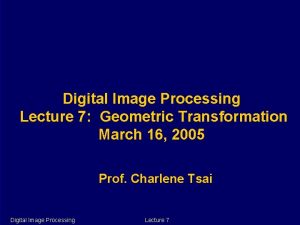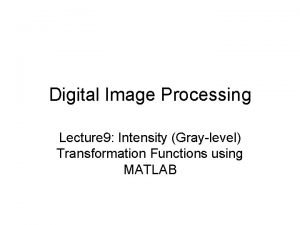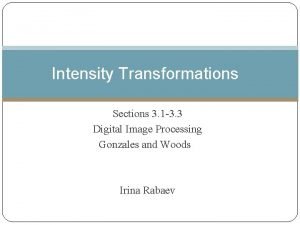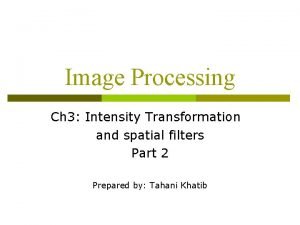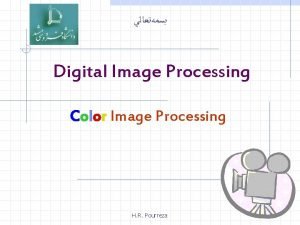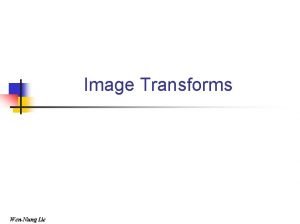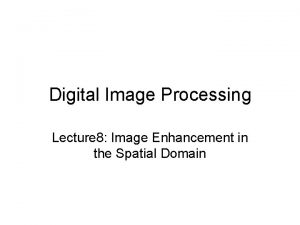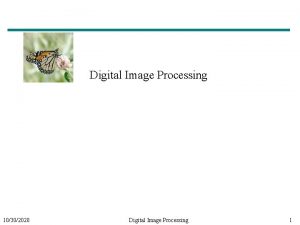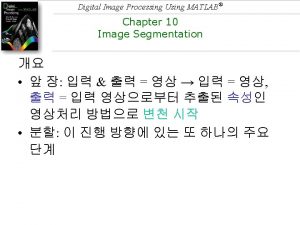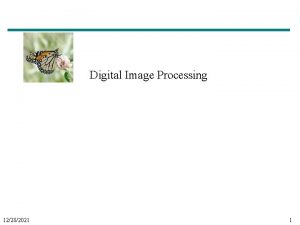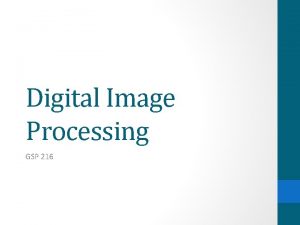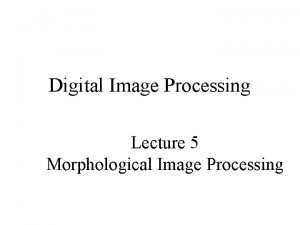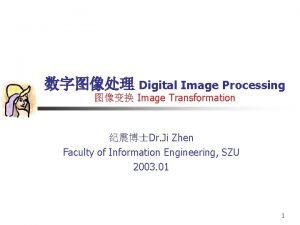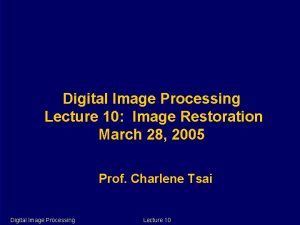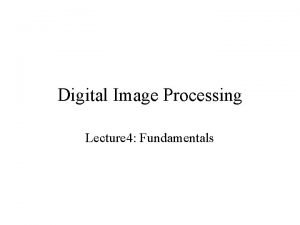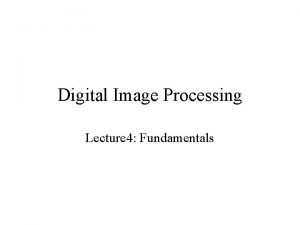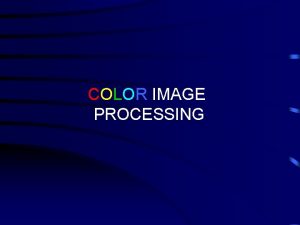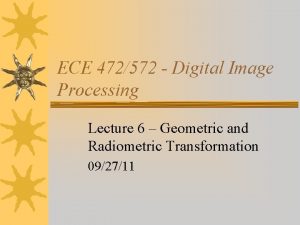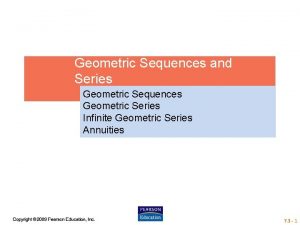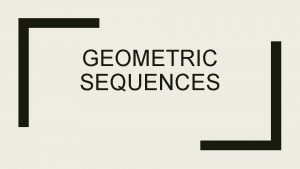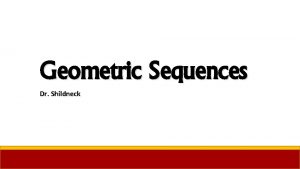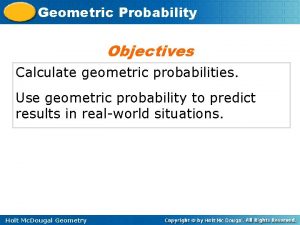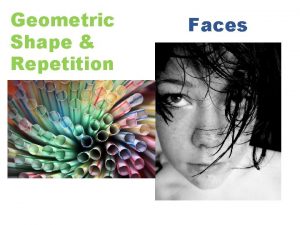Digital Image Processing Lecture 7 Geometric Transformation March






























- Slides: 30

Digital Image Processing Lecture 7: Geometric Transformation March 16, 2005 Prof. Charlene Tsai Digital Image Processing Lecture 7

Review § A geometric transform of an image consists of two basic steps § Step 1: determining the pixel co-ordinate transformation § Step 2: determining the brightness of the points in the digital grid. T(x, y) § In the previous lecture, we discussed brightness interpolation and some variations of affine transformation. Digital Image Processing Lecture 7 2

Affine Transformation (con’d) § An affine transformation is equivalent to the composed effects of translation, rotation and scaling. § The general affine transformation is commonly expressed as below: 0 th order coefficients Digital Image Processing 1 st order coefficients Lecture 7 3

General Formulation § A geometric transform is a vector function T that maps the pixel (x, y) to a new position (x’, y’): § Tx(x, y) and Ty(x, y) are usually polynomial equations. § This transform is linear with respect to the coefficients ark and brk. Digital Image Processing Lecture 7 4

Finding Coefficients § How to find ark and brk, which are often unknown? § Finding pairs of corresponding points (x, y), (x’, y’) in both images, § Determining ark and brk by solving a set of linear equations. § More points than coefficients are usually used to get robustness. Least-squares fitting is often used. Digital Image Processing Lecture 7 5

Jacobian § A geometric transform applied to the whole image may change the co-ordinate system, and a Jacobian J provides information about how the co-ordinate system changes § The area of the image is invariant if and only if |J|=1 (|J| is the determinant of J). § What is the Jacobian of an affine transform? Digital Image Processing Lecture 7 6

Variation of Affine (2 D) § Translation: displacement § Euclidean (rigid): translation + rotation § Similarity: Euclidean + scaling (for isotropic scaling, sx = sy) Digital Image Processing Lecture 7 7

Types of transformations (2 D) § Affine: Similarity + shearing § Some illustrations of shearing effects (courtesy of Luis Ibanez) Digital Image Processing Lecture 7 8

Affine transform § Shearing in x-direction a 01 y y (x, y) y y’ ( x + a 01 y , y ) x’ x x Digital Image Processing Lecture 7 9

Affine transform § Shearing in y-direction y ( x , y + b 10 x ) y y’ b 10 x x’ (x, y) x Digital Image Processing x Lecture 7 10

Invariant Properties § Translation: § Euclidean: § Similarity: § Affine: Digital Image Processing Lecture 7 11

Types of transformations (2 D) § Bilinear: Affine + warping § Quadratic: Affine + warping Digital Image Processing Lecture 7 12

Least-Squares Estimation § Because of noise in the images, if there are more correspondence pairs than minimally required, it is often not possible to find a transformation that satisfies all pairs. § Objective: To minimize the sum of the Euclidean distances of the correspondence set C={pi, qi}, where pi={xi, yi}, and qi is the corresponding point. Digital Image Processing Lecture 7 13

Least-Squares Estimation - Affine § For affine model, § The Euclidean error , where § With the new notation, § To find Digital Image Processing which minimize Lecture 7 we want 14

Least-Squares Estimation - Affine § This leads to § Therefore, Digital Image Processing Lecture 7 15

Some remarks § So far, we only discussed global transformation (applied to entire image) § It is possible to approximate complex geometric transformations (distortion) by partitioning an image into smaller rectangular sub-images. § for each sub-image, a simple geometric transformation, such as the affine, is estimated using pairs of corresponding pixels. § geometric transformation (distortion) is then performed separately in each sub-image. Digital Image Processing Lecture 7 16

Real Application § Registration of retinal images of different modalities § Importance? Color slide Digital Image Processing Fluorocein Angiogram Lecture 7 17

Mosaicing Mosaic Digital Image Processing Lecture 7 18

Fusion of medical information Digital Image Processing Lecture 7 19

Change Detection Digital Image Processing Lecture 7 20

Computer-assisted surgery Digital Image Processing Lecture 7 21

What is needed? § A known transformation, which is less likely OR § Computing the transformation from features. § Feature extraction § Features in correspondence § Transformation models § Objective function Digital Image Processing Lecture 7 22

What might be a good feature? Color slide Digital Image Processing Fluorocein Angiogram Lecture 7 23

Feature Extraction Digital Image Processing Lecture 7 24

Features in Correspondence (crossover & branching points) Digital Image Processing Lecture 7 25

Features in Correspondence (vessel centerline points) Digital Image Processing Lecture 7 26

Transformation Models p 12 -parameter quadratic transformation q Digital Image Processing Lecture 7 27

Transformation Model Hierarchy Similarity Affine Reduced Quadratic Digital Image Processing Lecture 7 28

Objective Function Transformation parameters Feature point in image Set of correspondences Feature point in image Mapping of features from Digital Image Processing to based on Lecture 7 29

Result Digital Image Processing Lecture 7 30
 Geometric transformation in digital image processing
Geometric transformation in digital image processing Image processing lecture
Image processing lecture Basic intensity transformation in digital image processing
Basic intensity transformation in digital image processing Gray level transformation in digital image processing
Gray level transformation in digital image processing Power law transform
Power law transform Intensity transformation in digital image processing
Intensity transformation in digital image processing Image processing
Image processing Piecewise linear transformation in digital image processing
Piecewise linear transformation in digital image processing Histogram processing in digital image processing
Histogram processing in digital image processing Neighborhood processing in image processing
Neighborhood processing in image processing Nonlinear image processing
Nonlinear image processing Point processing
Point processing Fractal
Fractal Digital image processing
Digital image processing Image transform in digital image processing
Image transform in digital image processing Noise
Noise Image compression in digital image processing
Image compression in digital image processing Key stages in digital image processing
Key stages in digital image processing Lossless image compression matlab source code
Lossless image compression matlab source code Image sharpening in digital image processing
Image sharpening in digital image processing Steps in digital image processing
Steps in digital image processing Image transforms in digital image processing
Image transforms in digital image processing Maketform matlab
Maketform matlab Noise
Noise Anthem of poland
Anthem of poland Image processing lecture notes
Image processing lecture notes Kl transform example
Kl transform example Power law transformation in image processing example
Power law transformation in image processing example Hit or miss transformation in image processing
Hit or miss transformation in image processing Image negatives a gray level transformation is defined as
Image negatives a gray level transformation is defined as Image representation and description
Image representation and description

